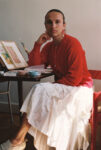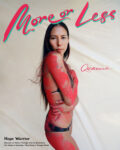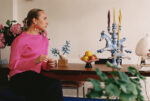About me:
My name is Alfred Bramsen, I am from Copenhagen, Denmark, living in London, and I work as an illustrator, curator of interiors and creative consultant.
I have recently opened an online homeware space called Noren, which carries various goods primarily from Denmark and Japan: both vintage items that I collect, and product from other creatives, some of which we design together. Being able to highlight two cultures, – one where I am from and the other that I am a great admirer of – is a great privilege.
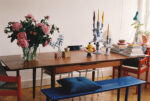
I like to collect a lot of items, big and small, which make perfect additions to the tablescape.

How to... set a table
A table has the power to set the tone and make a big impact in a room. Being such a large surface, the possibilities are endless, really. I like to collect a lot of items, big and small, which make perfect additions to the tablescape.
The first thing I think about when setting the table is, what will the main theme of the tablescape be? It the flowers, a cake, the candelabras, or all of the above? The most regular setting probably includes flowers; I always go for flowers that are in season. Usually I don’t mix flowers; sticking to one type of stem is less to think about, and, you really bring that seasonal flower to the forefront.
Then I like to go in with some larger accent pieces, whether that is books, candlesticks, bowls etc. I like to choose some items that are relevant to what I am currently doing or working on. If I am using certain books for work I would put those on the table. It sort of works, as it’s another piece of a sort of visual way of working – if that makes sense!
After you have set a bit of a layout, perhaps flowers down one end and the books at the other, then it’s time to go in with the cute little bits and bobs that tie it all together. A little figurine found at a flea market or a paper flower that you got as a gift from a friend. These little trinkets scattered across the table can really finish the tone.

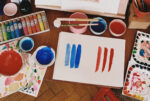
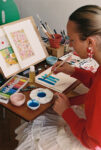
I draw a lot of inspiration from Nihonga techniques.
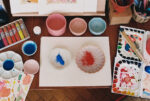
How to... Mix paints and draw
I love painting supplies, especially Japanese paints. At the moment I am using a lot of Japanese mineral pigments in my illustrations; these are made from natural ores. I draw a lot of inspiration in my techniques from Nihonga techniques. Nihonga is a term that originated in the Meiji period to differentiate traditional Japanese paintings from western-style oil paintings.
First I take a third of a teaspoon (or the other end of a teaspoon) to scoop out a tiny bit of pigment on to a plate.
If I am using hard pigments that have not been powderised I will first grind the pigments with a ceramic pestle. The texture of the paint varies depending on the size of the minerals in the pigment.
After that I add animal glue little by little and start kneading the pigment in circles until it forms a paste. Then, after a while, it becomes an opaque paint. Depending on my desired texture, I can dilute it with a little water.
Now you are ready to paint.
